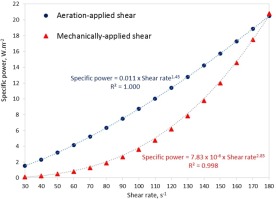当前位置:
X-MOL 学术
›
Water Res.
›
论文详情
Our official English website, www.x-mol.net, welcomes your
feedback! (Note: you will need to create a separate account there.)
Comparative power demand of mechanical and aeration imposed shear in an immersed membrane bioreactor
Water Research ( IF 11.4 ) Pub Date : 2017-09-12 , DOI: 10.1016/j.watres.2017.09.024 P. Buzatu , H. Qiblawey , M.S. Nasser , S. Judd
Water Research ( IF 11.4 ) Pub Date : 2017-09-12 , DOI: 10.1016/j.watres.2017.09.024 P. Buzatu , H. Qiblawey , M.S. Nasser , S. Judd

|
The power demanded for the application of mechanically-imposed shear on an immersed flat sheet (iFS) membrane bioreactor (MBR) has been compared to that of conventional membrane air scouring. Literature correlations based on the Ostwald model were used to define the rheological characteristics of an MBR sludge. The correlation of specific power demand (, in Watts per m2 membrane area) with shear rate γ in s-1 was developed from first principles through a consideration of the force balance on the system in the case of mechanically-imposed shear. The corresponding aeration imposed shear correlation was interpreted from literature information.The analysis revealed the energy required to impose a shear mechanically through oscillation (or reciprocation) of the membrane to be between 20 and 70% less than that demanded for providing the same shear by conventional aeration of the immersed membrane. The energy saving increases with decreasing shear in accordance with a power demand ratio (aeration:mechanical) of 1400γ-1.4 for a specific sludge rheology. Whilst the absolute  value is dependent on the sludge rheology, the aeration:mechanical power demand ratio is determined by the difference in the two exponents in the respective correlations between
value is dependent on the sludge rheology, the aeration:mechanical power demand ratio is determined by the difference in the two exponents in the respective correlations between  and γ. Consequently, aeration-imparted shear becomes energetically favoured beyond some threshold shear rate value (∼180 s-1, based on the boundary conditions applied in the current study). The outcomes qualitatively corroborate findings from the limited practical measurement of energy demand in MBRs fitted with reciprocating immersed membranes.
and γ. Consequently, aeration-imparted shear becomes energetically favoured beyond some threshold shear rate value (∼180 s-1, based on the boundary conditions applied in the current study). The outcomes qualitatively corroborate findings from the limited practical measurement of energy demand in MBRs fitted with reciprocating immersed membranes.
中文翻译:

浸入式膜生物反应器中机械和曝气施加的剪切的比较功率需求
将机械施加剪切力应用于浸入式平板(iFS)膜生物反应器(MBR)所需的功率已与常规膜空气精练进行了比较。基于Ostwald模型的文献相关性用于定义MBR污泥的流变特性。特定功率需求的相关性(,以瓦特/ m 2膜面积为单位),在考虑机械施加剪切力的情况下,从第一原理出发,通过考虑系统上的力平衡,得出了剪切速率γ在s -1中。从文献资料中解释了相应的曝气施加的剪切相关性。分析表明,通过膜的振动(或往复运动)机械施加剪切所需要的能量比常规提供相同剪切所需要的能量少20%至70%。浸没膜的通气。节能与根据功率需求比(曝气:机械)降低剪切增加1400的γ -1.4特定污泥流变性。虽然绝对 值取决于污泥的流变性,曝气:机械动力需求比由两个指数之间的相关性中的两个指数之差确定
值取决于污泥的流变性,曝气:机械动力需求比由两个指数之间的相关性中的两个指数之差确定  和γ。因此,在某些阈值剪切速率值(基于当前研究中所应用的边界条件为〜180 s -1)之外,通气赋予的剪切力在能量上受到青睐。该结果在质量上证实了来自配备往复式浸没膜的MBR能源需求的有限实际测量结果。
和γ。因此,在某些阈值剪切速率值(基于当前研究中所应用的边界条件为〜180 s -1)之外,通气赋予的剪切力在能量上受到青睐。该结果在质量上证实了来自配备往复式浸没膜的MBR能源需求的有限实际测量结果。
更新日期:2017-09-12
中文翻译:

浸入式膜生物反应器中机械和曝气施加的剪切的比较功率需求
将机械施加剪切力应用于浸入式平板(iFS)膜生物反应器(MBR)所需的功率已与常规膜空气精练进行了比较。基于Ostwald模型的文献相关性用于定义MBR污泥的流变特性。特定功率需求的相关性(,以瓦特/ m 2膜面积为单位),在考虑机械施加剪切力的情况下,从第一原理出发,通过考虑系统上的力平衡,得出了剪切速率γ在s -1中。从文献资料中解释了相应的曝气施加的剪切相关性。分析表明,通过膜的振动(或往复运动)机械施加剪切所需要的能量比常规提供相同剪切所需要的能量少20%至70%。浸没膜的通气。节能与根据功率需求比(曝气:机械)降低剪切增加1400的γ -1.4特定污泥流变性。虽然绝对











































 京公网安备 11010802027423号
京公网安备 11010802027423号